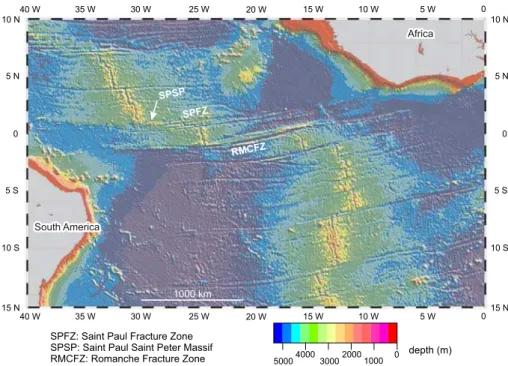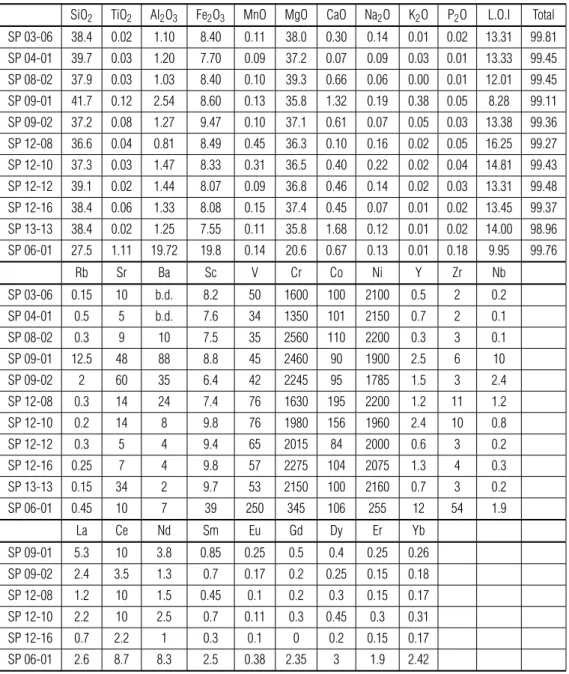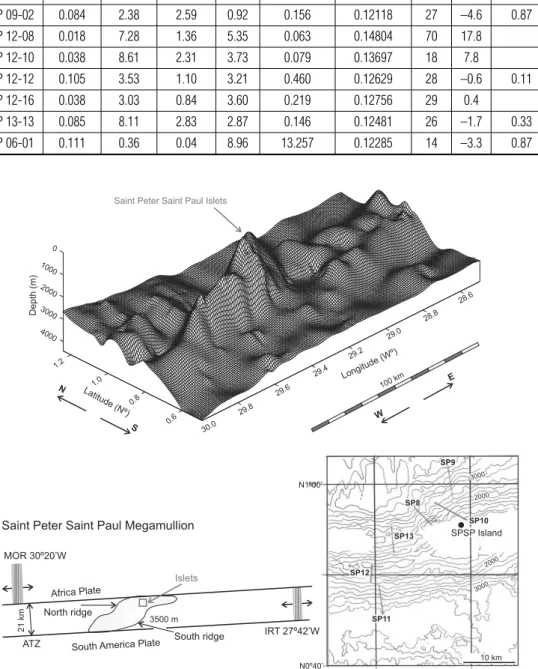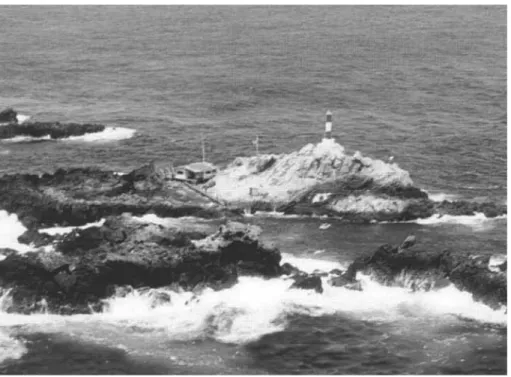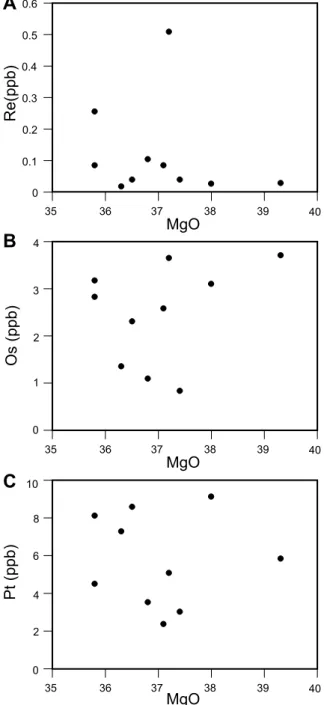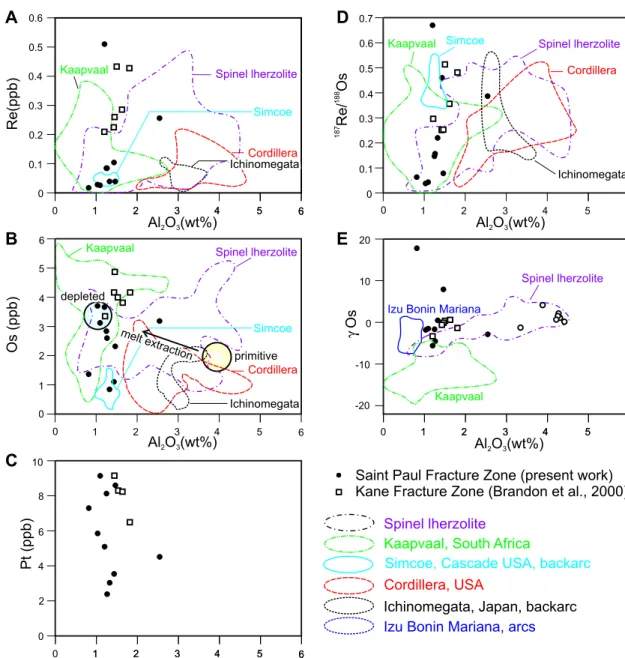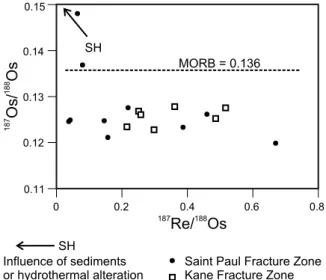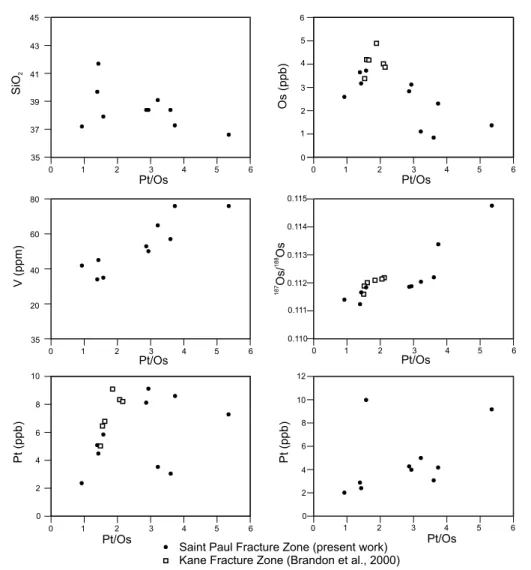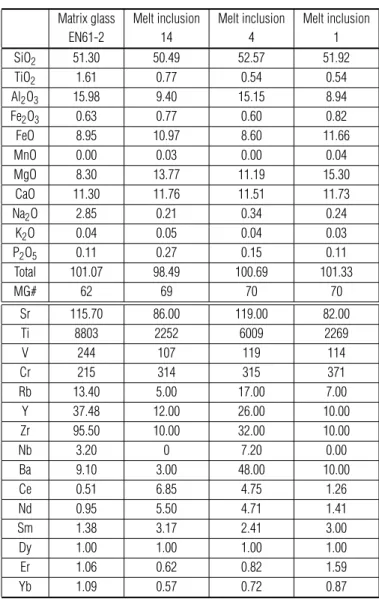www.scielo.br/rbg
GEOPHYSICAL AND GEOCHEMICAL EVIDENCE FOR COLD UPPER MANTLE
BENEATH THE EQUATORIAL ATLANTIC OCEAN
Susanna Eleonora Sichel
1, Sonia Esperanc¸a
2, Akihisa Motoki
3, Marcia Maia
4,
Mary F. Horan
5, Peter Szatmari
6, Eliane da Costa Alves
7and Sidney L.M. Mello
8Recebido em 14 setembro, 2007 / Aceito em 24 janeiro, 2008 Received on September 14, 2007 / Accepted on January 24, 2008
ABSTRACT.This paper presents geophysical and geochemical evidence for the possible existence of cold, subducted lithosphere beneath the Saint Paul Fracture Zone of the Equatorial Atlantic Ocean. The ocean floor along the fracture zone is characterized by a high percentage of abyssal peridotites. The abyssal peridotites were emplaced by tectonic uplift of the oceanic lithosphere. The top of the ridge is exposed at Saint Peter and Saint Paul islets. The Os isotopic composition of these abyssal peridotites indicate the presence of old depleted mantle material in this region with Re-depletion model ages (TRD) from 0.32 to 1.1 Ga. Melt inclusions in plagioclase phenocrysts of the MORB close to this location have boninitic composition, suggesting that some basalts originated from low-degree mantle melting. The global tomography models show fast seismic velocities in the upper and lower mantle of the Equatorial Atlantic Ocean, consistent with the presence of cold subducted lithosphere. The range of Re-depletion model ages are consistent with paleo-reconstructions of plate motion, suggesting that the fossil subducted slab was formed during the closure of both the Iapetus and the Rheic oceans.
Keywords: Equatorial Atlantic Ocean, Saint Paul Fracture Zone, abyssal mantle, Re-Os isotope system, cold mantle, fossil subducted slab.
RESUMO.O presente trabalho mostra evidˆencias geof´ısicas e geoqu´ımicas para a poss´ıvel existˆencia de fragmentos frios do manto originados da placa subductada abaixo da Zona de Fratura de S˜ao Paulo no Oceano Atlˆantico Equatorial. A plan´ıcie abissal desta ´area ´e caracterizada por uma abundˆancia de rochas peridot´ıticas, com presenc¸a de poucas rochas bas´alticas originadas de baixo grau de fus˜ao parcial. Arquip´elago de S˜ao Pedro e S˜ao Paulo se localiza no topo de uma elevac¸˜ao morfol´ogica com mais de 4000 m de altura, constitu´ıda por peridotitos abissais, posicionados por um soerguimento tectˆonico da litosfera oceˆanica. A raz˜ao isot´opica de Os dos peridotitos da Zona de Fratura de S˜ao Paulo indica a presenc¸a de materiais originados de antigo manto depletado nesta regi˜ao com as idades modelo de 0.32 a 1.1 Ga. As inclus˜oes de magma trapeadas nos fenocristais de plagiocl´asio nos basalto da cadeia meso-oceˆanica pouco mais ao sul apresentam composic¸˜ao bonin´ıtica, t´ıpicas de zona de arco. Os modelos da tomografia mundial do manto demonstram alta velocidade s´ısmica tanto no manto superior quanto no inferior do Oceano Atlˆantico Equatorial, o que corrobora a interpretac¸˜ao da presenc¸a de placa subductada de baixa temperatura. As idades do modelo de deplec¸˜ao de Re dos peridotitos s˜ao consistentes com a reconstituic¸˜ao de movimento das placas, sugerindo que os fragmentos de placa f´ossil subductada s˜ao provenientes do fechamento tanto do Oceano Iapetus como o do Oceano Rheic.
Palavras-chave: Oceano Atlˆantico Equatorial, Zona de Fratura de S˜ao Paulo, manto abissal, sistema isot´opico Re-Os, manto frio, placa f´ossil subductada.
1Departamento de Geologia, LAGEMAR, Universidade Federal Fluminense, Brazil. E-mail: susanna@igeo.uff.br 2Division of Earth Sciences, National Science Foundation, Arlington, VA 22230, USA. E-mail: sesperan@nsf.gov
3Departamento de Mineralogia e Petrologia ´Ignea, Universidade do Estado do Rio de Janeiro, Brazil. E-mail: amotoki@pesquisador.cnpq.br 4CNRS, UMR 6538 Domaines Oc´eaniques, IUEM, Plouzan´e, France. E-mail: marcia@univ-brest.fr
5DTM-CIW, 5241 Broad Branch Rd, Washington DC, USA. E-mail: mhoran@ciw.edu 6CENPES-PETROBRAS, Brazil. E-mail: szatmari@petrobras.com.br
INTRODUCTION
Lateral variations in the temperature of the Earth’s mantle have significant influence on the morphological and structural cha-racteristics of mid-oceanic ridges. Hotspots, such as Iceland and Azores, induce excess axial morphologic elevation, with high magma production and consequently thickened crust. On the other hand, transform fault zones represent morphological de-pressions, with low magma production, and thin oceanic crust (Schilling et al., 1995; Thibaud et al., 1998). In some localities, serpentinized mantle peridotite is exposed directly on the abys-sal surface, forming elliptic hills called “megamullion” (Tucholke et al., 1998, 2001; Ohara et al., 2001). These areas, so-called “cold spots”, or “cold zones”, are less common and little unders-tood in comparison with hotspots. The best-known case is the Australian-Antarctic Discordance, called AAD, which probably reflects the presence of the cold, subducted lithosphere in the mantle (Gurnis et al., 1998; Ritzwoller et al., 2003), also called “megalith” (Fukao et al., 1994; Maruyama, 1994). A second pro-bable cold spot lies in the equatorial region of the Atlantic Ocean. The primary evidence for the presence of cold upper mantle beneath the Equatorial Mid-Atlantic Ridge comes from the struc-tural analysis of the ridge axis morphology and the petrology of both basaltic and peridotitic rocks dredged from the area (Fig. 1; Gorini, 1981; Bonatti & Honnorez, 1970; Bonatti, 1990; Bonatti et al., 1993; Schilling et al., 1995). Deep axial domains are usually associated with colder mantle temperature, generally along the length of the transform fault. For example, the Australian-Antarctic Discordance is characterized by a depth anomaly of about 800 meters (Christie et al., 1998). In the Equatorial Atlantic Ocean, the deepest point is located at southern part of the Saint Paul transform fault fracture zone (Schilling et al., 1995), with depth anomaly of about 700 m. The basalt samples from the Equatorial Mid-Atlantic Ridge have different compositions from other parts of the mid-oceanic ridge system, and show a notable enrichment of incompatible elements. This phenomenon is attributed to melt enrichment derived from low degree of partial melts from a deeper but relatively colder upper mantle. Schilling et al. (1995) estima-ted that the temperature of this region may be 100 to 150◦C lower
than other areas of normal Mid-Atlantic Ridge.
The geometry of the ridge axis at the Equatorial Mid-Atlantic Ridge is marked by one of the largest offsets of the whole Atlan-tic Ocean (Fig. 1). Cold barrier effects of the exceptionally long transform faults (Fox & Gallo, 1984) could be partially responsi-ble for the low mantle temperature and consequent low melting rates. However, this factor is not enough to explain the entire
re-duction in temperature observed (Bonatti et al., 1993; Schilling et al., 1995). Moreover, numerical modelling suggests that the cold barrier effect is localized, extending only a few kilometres away from the ridge-transform intersection (Schilling et al., 1995).
Two models for the formation of the cold upper mantle have been suggested. Bonatti (1990) proposed the possible existence of downwelling of mantle flow in a broad area of the Equatorial Atlantic region. The cold mantle mass could have originated from sub-continental lithospheric blocks entrained in the upper mantle during the continental rifting of West-Gondwana and subsequent formation of the Atlantic Ocean. In an alternative model, Schilling et al. (1995) attributed the cold mantle to an accumulation of sub-ducted oceanic lithosphere at the margin of the Iapetus and Rheic Oceans from the time of Pangea formation.
In order to constrain further the origin of the cold mantle of Equatorial Atlantic zone, this study combines geochemical and geophysical data of the area around Saint Paul transform fault fracture zone.
GEOCHEMISTRY OF THE ABYSSAL PERIDOTITE
A suite of samples was collected from a large area around the Saint Paul Fracture Zone during a deep sea diving survey using the scientific submersible Nautile (Hekinian et al., 2000). Ten abys-sal peridotitic rocks and one of baabys-saltic dyke sample were selec-ted for the analyses of major elements, trace elements (Table 1), including Re, Pt, and Os contents, and Os isotopic ratios (Ta-ble 2). The chemical analyses were performed at CNRS-Universit´e de Bretagne Occidentale, France, following the protocol described in Cotten et al. (1995).
Samples for this study were collected in 7 of the 13 dives along the intra-transform ridges (Fig. 2), and from the North and the South Ridges of the Saint Peter Saint Paul massif. This massif is about 90 km long and 21 km wide at the 3000 m depth contour line, composed of two E-W trending ridges, called, respectively, North Ridge and South Ridge, forming an “S” shaped morpho-logic high (Hekinian et al., 2000). The highest point is on the North Ridge, exposing its top above the sea level as small islands. They are called officially by the Brazilian Government “Arqui-p´elago de S˜ao Pedro e S˜ao Paulo”.
Figure 1– Satellite predicted bathymetry (Smith & Sandwell, 1997) of the mid-oceanic ridge in Equatorial Atlantic region.
are best situated to present the mantle-derived residual material than may yield geochemical information regarding the underlying mantle evolution. Os is highly compatible in mantle assemblages and has a notable contrast with Re partitions into the melt. Epi-sodes of mantle melting therefore, slow or stop the ingrowths of radiogenic187Os over time, and allow the Re-Os isotope system
to be used to constrain the depletion history of the mantle (Shirey & Walker, 1998).
Determination of reliable geochemical information of the abyssal peridotite is not easy because of seawater alteration and serpentinization, hydrothermal fluid interaction at high and low temperatures, and potential contamination by ocean floor sedi-ment. The major element composition indicates high loss-on-ignition (Table 1), as expected from the intensity of serpentini-zation. Snow & Dick (1995) showed that some major elements, such as Mg, can be removed during alteration on the seafloor. M´evel (2003) stated that the serpentinization has little effect on most elements except for CaO, and that the MgO loss would take place only in low temperature weathering conditions of less than 100◦C.
Figure 4 shows Re, Os, and Pt variations with MgO contents. The Re and Os abundances have almost no correlation to MgO, although Re addition during the serpentinization or hydrothermal alteration is possible. It is unlikely that these processes would add Os to the mantle peridotite. Likewise, the Pt contents
ap-pear to have no correlation with MgO, indicating that Pt is also little influenced by seafloor alteration. The peridotite samples have high MgO concentrations that are not clearly correlated with CaO, which is a highly mobile element during alteration. These observations indicate that the major element composition of these peridotite samples was not significantly affected by serpentiniza-tion or hydrothermal alteraserpentiniza-tion even at low temperature. There-fore, the major and trace element variations may reflect directly the chemical characteristics of the oceanic mantle. For instance, the samples of Saint Paul Fracture Zone have lower Al2O3and CaO
contents than the peridotitic rocks of the Kane Fracture Zone. These differences in major element composition are possibly a reflection of oceanic mantle chemical heterogeneities between above-mentioned areas.
It is noteworthy that sample SP 06-01 has low SiO2 and
MgO, but high Al2O3and FeO. This sample was extracted from
a dyke and possibly represents a vein formed by the interaction of melts or fluids derived from peridotite in the oceanic lithosphere. This interpretation is consistent with high Ti, V and Sc contents, low Cr and Ni, and less radiogenic Os isotopic ratio of this sample (Tables 1-2). Therefore, this sample is excluded from the dia-grams for peridotite samples.
An inverse correlation between Os and Al2O3contents is
Table 1– Bulk rock composition of the Saint Paul Fracture Zone samples. XRF analyses have been performed at Universit´e de Bretagne Occidentale, Brest, France. Major elements are expressed in weight % and trace elements in ppm.
SiO2 TiO2 Al2O3 Fe2O3 MnO MgO CaO Na2O K2O P2O L.O.I Total
SP 03-06 38.4 0.02 1.10 8.40 0.11 38.0 0.30 0.14 0.01 0.02 13.31 99.81 SP 04-01 39.7 0.03 1.20 7.70 0.09 37.2 0.07 0.09 0.03 0.01 13.33 99.45 SP 08-02 37.9 0.03 1.03 8.40 0.10 39.3 0.66 0.06 0.00 0.01 12.01 99.45 SP 09-01 41.7 0.12 2.54 8.60 0.13 35.8 1.32 0.19 0.38 0.05 8.28 99.11 SP 09-02 37.2 0.08 1.27 9.47 0.10 37.1 0.61 0.07 0.05 0.03 13.38 99.36 SP 12-08 36.6 0.04 0.81 8.49 0.45 36.3 0.10 0.16 0.02 0.05 16.25 99.27 SP 12-10 37.3 0.03 1.47 8.33 0.31 36.5 0.40 0.22 0.02 0.04 14.81 99.43 SP 12-12 39.1 0.02 1.44 8.07 0.09 36.8 0.46 0.14 0.02 0.03 13.31 99.48 SP 12-16 38.4 0.06 1.33 8.08 0.15 37.4 0.45 0.07 0.01 0.02 13.45 99.37 SP 13-13 38.4 0.02 1.25 7.55 0.11 35.8 1.68 0.12 0.01 0.02 14.00 98.96 SP 06-01 27.5 1.11 19.72 19.8 0.14 20.6 0.67 0.13 0.01 0.18 9.95 99.76
Rb Sr Ba Sc V Cr Co Ni Y Zr Nb SP 03-06 0.15 10 b.d. 8.2 50 1600 100 2100 0.5 2 0.2 SP 04-01 0.5 5 b.d. 7.6 34 1350 101 2150 0.7 2 0.1 SP 08-02 0.3 9 10 7.5 35 2560 110 2200 0.3 3 0.1 SP 09-01 12.5 48 88 8.8 45 2460 90 1900 2.5 6 10 SP 09-02 2 60 35 6.4 42 2245 95 1785 1.5 3 2.4 SP 12-08 0.3 14 24 7.4 76 1630 195 2200 1.2 11 1.2 SP 12-10 0.2 14 8 9.8 76 1980 156 1960 2.4 10 0.8 SP 12-12 0.3 5 4 9.4 65 2015 84 2000 0.6 3 0.2 SP 12-16 0.25 7 4 9.8 57 2275 104 2075 1.3 4 0.3 SP 13-13 0.15 34 2 9.7 53 2150 100 2160 0.7 3 0.2 SP 06-01 0.45 10 7 39 250 345 106 255 12 54 1.9
La Ce Nd Sm Eu Gd Dy Er Yb SP 09-01 5.3 10 3.8 0.85 0.25 0.5 0.4 0.25 0.26 SP 09-02 2.4 3.5 1.3 0.7 0.17 0.2 0.25 0.15 0.18 SP 12-08 1.2 10 1.5 0.45 0.1 0.2 0.3 0.15 0.17 SP 12-10 2.2 10 2.5 0.7 0.11 0.3 0.45 0.3 0.31 SP 12-16 0.7 2.2 1 0.3 0.1 0 0.2 0.15 0.17 SP 06-01 2.6 8.7 8.3 2.5 0.38 2.35 3 1.9 2.42
187Os/188Os with Al
2O3(wt%). The absence of clear correlation
between the platinum group elements and a melt-depletion proxy, such as Al2O3, indicates that the peridotite samples are not the
result of a single melt-depletion event. The highest Os concen-trations of the Saint Paul peridotites are projected on the range of the abyssal peridotites of the Kane Fracture Zone (Brandon et al., 2000). These values are reasonable for a depleted mantle source. Many samples of the Saint Paul Fracture Zone have lower Re and Os but similar Pt contents than those of the Kane Fracture
Table 2– Re, Pt, and Os concentrations and Os isotopic ratio of the Saint Paul Fracture Zone samples. Re, Os concentrations and Os isotopic analysis have been performed at the IGL-Univ. of Maryland-College Park, according to the procedures of Meisel et al. (2001). Pt concentrations obtained by isotope dilution mass spectrometry at the Department of Terrestrial Magnetism, Carnegie Institution of Washington according to the procedures of Horan et al. (2003). The sample SP 06-01 is extracted from a dyke and the others are serpentinized peridotite.
Re (ppb) Pt (ppb) Os (ppb) Pt/Os 187Re/188Os 187Os/188Os error γOs TRD (Ga)
SP 03-06 0.027 9.13 3.11 2.94 0.042 0.12497 30 –1.6 0.31 SP 04-01 0.508 5.08 3.66 1.39 0.669 0.11988 300 –5.6 1.10 SP 08-02 0.028 5.86 3.71 1.58 0.037 0.12464 21 –1.9 0.35 SP 09-01 0.255 4.50 3.18 1.42 0.386 0.12333 27 –2.9 0.55 SP 09-02 0.084 2.38 2.59 0.92 0.156 0.12118 27 –4.6 0.87 SP 12-08 0.018 7.28 1.36 5.35 0.063 0.14804 70 17.8 SP 12-10 0.038 8.61 2.31 3.73 0.079 0.13697 18 7.8
SP 12-12 0.105 3.53 1.10 3.21 0.460 0.12629 28 –0.6 0.11 SP 12-16 0.038 3.03 0.84 3.60 0.219 0.12756 29 0.4
SP 13-13 0.085 8.11 2.83 2.87 0.146 0.12481 26 –1.7 0.33 SP 06-01 0.111 0.36 0.04 8.96 13.257 0.12285 14 –3.3 0.87
Figure 3– Panoramic view from a helicopter of the Saint Peter Saint Paul Massif, Equatorial Atlantic region, after SECIRM (Secretaria da Comiss˜ao Interministerial para Recursos do Mar), Brazilian Navy Force.
low Re contents of the peridotite samples, because sediments and amphibolite are typically enriched in Re relative to mantle assem-blages (Fig. 6C).
The same argument is valid for contamination of the perido-tites by MORBs, as most basaltic melts also have high Re con-tents. In addition to the depletion in Os and Re contents, the end-member with radiogenic Os isotopic composition has high Pt contents. The process that led to the depletion in Re and Os appears to be also capable of concentrating Pt. The radiogenic nature of this end member is a good indication that this mantle component is ancient. A study of mantle xenoliths from arc set-tings has shown that the oxidizing conditions of the mantle wedge above the subduction zones favors the removal of Re and Os from mantle assemblages (Brandon et al., 1996). Although it is not known how Pt would behave in similar conditions, it is possible that these chemical characteristics are inherited from an old sub-duction event.
The range of Os isotopic compositions obtained for this suite of rocks is large (187Os/188Os varies from 0.11988 to 0.14804)
but the majority of the samples hasγOs values that are equal to
or below chondritic values. These data cannot be explained sim-ply by melt extraction from a fertile MORB mantle with homoge-neous Os isotopic composition, and reinforce previous results by others indicating a sub-chondritic average for abyssal peridotites
(Martin, 1991; Roy-Barman & All`egre, 1994; Snow & Reisberg, 1995). The sub-chondritic Os isotopic composition of most of these peridotites also cannot be explained by interaction of the mantle assemblage with abyssal sediments that are significan-tly more radiogenic than the MORB mantle (Roy-Barman et al., 1998) or primitive upper mantle. Two peridotite samples have significantly higher Os concentrations and more radiogenic Os isotopic ratios. These characteristics could be attributed to possi-ble assimilation of sediments and interaction of enriched melts or fluids (Fig. 7).
The chondritic to sub-chondritic Os isotopic composition of most Saint Paul Fracture Zone peridotites contrasts with models of Os isotopic evolution of the primitive upper mantle as constrained by spinel lherzolites from continental environments that support a more chondritic value for the bulk upper mantle (Meisel et al., 1996, 2001). Model ages for Re-depletion for the sub-chondritic samples are in the range of 320 Ma to 1,100 Ma, being classified into three groups:
1) Middle Proterozoic, about 1,100 Ma (SP 04-01, SP 12-12);
2) Late Proterozoic, 870 Ma (SP 09-02, SP 06-01); and
These ages might record depletion events of the abyssal perido-tite and consequent old oceanic crust formation.
Figure 4– Re, Os, and Pt contents versus MgO for the peridotite samples of the Saint Peter Fracture Zone of the present work.
This range of depletion model ages for the sampled mantle rocks is consistent with three different hypotheses:
1) Os isotopic composition of the MORB mantle is more un-radiogenic than previously thought;
2) Abyssal peridotites entrained pieces of old continental
lithosphere delaminated during the opening of the Atlantic Ocean; and
3) Abyssal peridotites inherited unradiogenic Os from deple-ted portions of fossil subducdeple-ted slab, or megaliths.
The first hypothesis is less consistent with available data on chromite obtained from ophiolite sequences that have crystallised during oceanic lithosphere formation (Walker, 1989), and the limi-ted but robust set of Os isotopic compositions of primitive basaltic rocks from oceanic environments (Lassiter & Hauri, 1998). These data indicate that the MORB source, although somewhat hetero-geneous, has probably a chondritic to slightly super-chondritic Os isotope ratio.
The second and third hypotheses can be supported by the Re-Os isotopic composition presented. The sub-continental lithos-phere along the Atlantic Ocean margins in the equatorial region is much older than Pan-African (1.1-0.9 Ga). However, the age of melt depletion related to the formation of oceanic lithosphere, and its subsequent subduction during the closing of the Iapetus Sea in this region match better the Re-depletion model ages of the analysed peridotitic rocks.
The Os isotopic ratios of the Saint Paul Fracture Zone sam-ples are not correlated with their187Re/188Os ratio and can be
attributed to possible late Re mobilisation (Fig. 7). The data set shows a positive correlation between187Os/188Os and Pt/Os
(Fig. 8). The same relationship was observed in the abyssal pe-ridotites from Kane Fracture Zone (Brandon et al., 2000). In the Saint Paul Fracture Zone, Pt and Os concentrations also appear to be positively correlated, and the samples with higher Pt/Os ra-tios also have lower overall concentrations of these two platinum group elements.
MELT INCLUSION OF BONINITIC COMPOSITIONS
Figure 5– Re, Os and Pt concentration contents,187Re /188Os, andγOs plotted against Al2O3(wt%). The distribution fields of ultramafic rocks from
other regions are after a compilation by Carlson et al. (1999).
the host crystal, such as mineral growth. In order to evaluate the extent of host mineral crystallisation, it is important to note the re-lationship between the composition of the inclusion and the host mineral, zoning, or internal heterogeneity, which would provide a strong argument for the host mineral recrystallisation. Once host recrystallisation has been evaluated, the melt inclusion composi-tion can be adjusted back to its original entrapment composicomposi-tion. Sichel (1990) presented the analyses of the melt inclusi-ons in plagioclase phenocrysts and their host minerals,
obtai-ned from dredged samples of Mid-Atlantic Ridge (EN61-2D; lati-tude 2◦24’S). A group of plagioclase crystals appears to be in
equilibrium with the MORB matrix glass. However, the range in anorthite content for the plagioclase phenocrysts that contain melt inclusions goes up to An90, which can be interpreted as
Figure 6– Comparative diagram of Pt, Os, and Re variations against187Os /188Os of the Saint Peter Fracture Zone and the Kane Fracture Zone. The diagram B shows mixing lines for MORB, sediments and amphibole.
Figure 7–187Re/188Os versus187Os/188Os diagram for the peridotite samples of the Saint Paul Fracture Zone of this work and of the Kane Fracture Zone (Brandon et al., 2000). The
187Os/188Os ratio for MORB is taken from Roy-Barman et al. (1998).
The high MgO, high SiO2and enriched LREE of the melt
in-clusions are consistent with a boninitic composition. Boninite is a primary high-magnesia andesitic magma generated from the par-tial melting of young and hot oceanic crust in the presence of H2O,
pla-Figure 8– SiO2and trace elementsversusPt/Os composition of ultramafic rocks from Saint Paul Fracture Zone (present data) and from Kane Fracture Zone (Brandon et al., 2000).
gioclase phenocrysts in volcanic glasses from the Mid-Atlantic Ridge is consistent with melt contribution to MORBs from mag-mas generated from melting of slab material at depth.
SEISMIC TOMOGRAPHY
The topographic and mantle Bouguer anomaly (Fig. 9) sections across the Mid-Atlantic Ridge show a topographic low and a high Bouguer anomaly in the Equatorial Atlantic area in comparison with the other regions.
The attenuation Q model for seismic waves (Romanowicz & Gung, 2002; Gung & Romanowicz, 2004) demonstrates high Q values around the Mid-Atlantic Ridge of this region, implying cooler than normal mantle temperatures (Fig. 10). This surface anomaly corresponds to a high-Q body located in the lower part of the upper mantle. Global whole mantle tomographic models
(Boschi & Dziewonski, 1999; Ritsema & Van Heijst, 2000; Becker & Boschi, 2002) also show significantly high seismic velocities beneath the Equatorial Mid-Atlantic Ridge (Fig. 11).
Although global tomographic models have generally low re-solution at the surface (half-wavelength of∼1000 km), both the S and P models show high velocities in the upper mantle near the equatorial area. A notable characteristic of these whole-mantle seismological models is that the high velocity zone observed for the upper mantle apparently continues into the lower mantle. A similar phenomenon is observed in the present day subduction zones. This geophysical evidence is consistent with the presence of fossil subducted slab fragments in the mantle.
con-Table 3– Major elements (wt%) composition of matrix glass by XRF and melt inclusions in plagioclase by EPMA, and trace element contents (ppm) by ion probe at the MIT for the MORB samples collected from Equatorial Mid-Atlantic Ridge.
Matrix glass Melt inclusion Melt inclusion Melt inclusion
EN61-2 14 4 1
SiO2 51.30 50.49 52.57 51.92
TiO2 1.61 0.77 0.54 0.54
Al2O3 15.98 9.40 15.15 8.94
Fe2O3 0.63 0.77 0.60 0.82
FeO 8.95 10.97 8.60 11.66 MnO 0.00 0.03 0.00 0.04 MgO 8.30 13.77 11.19 15.30
CaO 11.30 11.76 11.51 11.73 Na2O 2.85 0.21 0.34 0.24
K2O 0.04 0.05 0.04 0.03
P2O5 0.11 0.27 0.15 0.11
Total 101.07 98.49 100.69 101.33
MG# 62 69 70 70
Sr 115.70 86.00 119.00 82.00
Ti 8803 2252 6009 2269
V 244 107 119 114
Cr 215 314 315 371
Rb 13.40 5.00 17.00 7.00 Y 37.48 12.00 26.00 10.00 Zr 95.50 10.00 32.00 10.00
Nb 3.20 0 7.20 0.00
Ba 9.10 3.00 48.00 10.00
Ce 0.51 6.85 4.75 1.26
Nd 0.95 5.50 4.71 1.41
Sm 1.38 3.17 2.41 3.00
Dy 1.00 1.00 1.00 1.00
Er 1.06 0.62 0.82 1.59
Yb 1.09 0.57 0.72 0.87
FeO = FeOtotal *0.9407.
tribute to maintain the low temperature in upper mantle long after the end of subduction. This low mantle temperature could decre-ase the magma production at the ridge axis, resulting in thinner crust and thicker lithosphere. The cold upper mantle would result in a highly segmented ridge axis system at greater depth, as is observed in the Australian-Antarctic Discordance.
KINEMATIC PALEO-RECONSTRUCTIONS
The existence of plate fragments in the Equatorial Atlantic region may be related to the numerous episodes of subduction that
Ameri-15S 10S 5S 0 5N 10N 20S
Latitude (degrees)
6000 0
d
e
p
th
(m)
2000
3000
4000
5000 1000
15S 10S 5S 0 5N 10N
20S
Latitude (degrees)
ma
n
tl
e
b
o
u
g
u
e
r
a
n
o
ma
ly
(mG
a
l)
100
0
-100
-200 200
Figure 9– Topographic (m) and Mantle Bouguer Anomaly (mGal) profile across the Mid-Atlantic Ridge. The red points represent bulk data and blue ones, best-fit model. Note the deepest depth and the highest MBA in the equatorial region.
Figure 10– A vertical section of the Berkeley Q model (Gung & Romanowicz, 2004) for the upper mantle along the axis of the Atlantic mid-oceanic ridge. Note the presence of sub-vertical high-Q wall below the equatorial region.
can continental block are far from the present Equatorial Atlantic Ocean. If their positions are referenced relative to the fixed loca-tions of hotspots, however, they are located in the present Equa-torial Atlantic region. Therefore, convergent margins could have
accumulated fossil slabs in the upper mantle below the present position of the Equatorial Atlantic Ocean.
possi-Figure 11– Comparison between two whole mantle P and S models (Boschi & Dziewonski, 1999; Ritsema & Van Heijst, 2000) and the average P and S-wave models of Becker & Boschi (2002). The average models enhance common and more stable features of different global tomographic models. Vertical sections are taken along the Mid-Atlantic Ridge axis.
ble origin for fragmentary blocks of oceanic lithosphere trapped in the upper mantle, which were remobilized upward during the subsequent rifting of Pangea and opening of the Atlantic Ocean (Fig. 13). An additional factor that could have contributed
frag-ments of subducted lithosphere to the upper mantle is the shear movement that may have been active between Early and Late Per-mian along this margin of Pangea (Muttoni et al., 2003).
Figure 12– Subduction zone positions relative to upper mantle after Dalziel (1997) for: A) Iapetus Ocean at Chilean Patagonia; B) Rheic Ocean at western Africa, forming Pangea. The latitude is referred to hotspot position. Note that both subduction zones are situated in present Equatorial Atlantic region (latitude 0◦).
Figure 13– Cartoons for the accumulation processes of cold lithospheric mantle fragments below the present position of the Equatorial Atlantic Ocean based on the plate movement model of Dalziel (1997): A) Rheic Ocean closing at the Early Permian; B) continental collision at the Late Permian; C) Pangea formation; D) Equatorial Atlantic Ocean opening and cold spot formation from the Early Cretaceous. The “absolute plate motion” of the illustration C corresponds to the plate movement relative to hotspots.
Discordance cold spot that, like the Equatorial Atlantic, has thin crust and a topographic low (Gurnis et al., 1998). The seismic to-mography similarly revealed a high velocity anomaly in the man-tle, interpreted as low mantle temperatures of this area that re-sulted from fragments of an ancient slab (Ritzwoller et al., 2003).
DISCUSSION
The Os isotopic ratios recorded in the abyssal peridotites, the degree of depletion of basalts and peridotites, the ridge axial morphology, and the high seismic mantle velocities support the existence of anomalous cold mantle material beneath the Equatorial Atlantic region. The Re depletion model ages and palaeo-reconstructions of the area both point to an event in the Palaeozoic, probably the closing of the Iapetus Sea. Entrainment of subducted depleted mantle materials during the formation of the Atlantic oceanic lithosphere could have imparted the non-radiogenic Os signature to the abyssal peridotites in this region.
Further evidence of subducted components beneath the Equa-torial Atlantic region comes from the trace element and isoto-pic composition of tholeiitic basalts from intra-transform ridges within the St. Paul Fracture Zone. These samples show eleva-ted Ce/Pb ratios, and87Sr/86Sr isotopic ratios that plot towards
the HIMU component of the oceanic array (Hemond et al., 2002), geochemical characteristics that are commonly interpreted to be inherited from ancient recycled oceanic crust.
The intense stretching of the lithosphere during the rifting and opening of the Equatorial Atlantic region might have induced dela-mination of the old continental lithosphere. The presence of cold continentally derived lithospheric fragments in the upper mantle could effectively reduce the average mantle temperature, thus yiel-ding low melting rates and high seismic velocities at higher levels in the mantle. However, the high seismic velocities observed into the lower mantle in this region are more easily explained by the presence of a subducted slab than by delamination and downwel-ling of large blocks of subcontinental lithosphere.
It is speculated that the subduction at the margin of the Rheic Ocean until 300 million years ago provided the fossil slab mass around the present day position of the Equatorial Atlantic region relative to hotspots. Such cold slab material can be seen in a high velocity zone in the lower mantle on the tomographic image. Although the subducted lithosphere could have been created in a divergent period prior to 460 million years ago, the younger age estimates seem to be more consistent with the depletion model ages obtained with the Re-Os system.
CONCLUSION
Combined geochemistry on abyssal peridotites from the Saint Paul Fracture Zone, recent whole mantle tomographic models, and kinematic palaeo-reconstructions indicate that low mantle temperatures in the Equatorial Atlantic Ocean result from frag-ments of a subducted slab in the upper mantle. The presence
of Mg-SiO2rich melt inclusions with LREE enrichment in MORB
samples is consistent with the suggestion that the underlying oce-anic mantle in the Equatorial Atlantic has chemical heterogenei-ties that are characteristic of those in arc settings. The colder lower mantle temperatures seen in global tomography models may have been induced by the detached cold slab fragments. These could also have the effect of cooling the upper mantle while maintaining a downwelling flow even without active present day subduction. Fragments of the subducted plate that were detached during ear-lier subduction could have melted or been entrained in the upper mantle, yielding the osmium isotopic compositions observed in the abyssal peridotites.
ACKNOWLEDGEMENT
The senior author is grateful to Roger Hekinian and Thierry Juteau for their mentorship and support during the cruise and to IFRE-MER for their support of the St. Paul Cruise of N/O Nadir and the Nautile. She also thanks Marcus Aguiar Gorini who offered her the unique opportunity for participating in the dives on the NAU-TILE submersible in the St. Paul Transform Fault Zone. Richard Walker generously provided access to the Isotopic Geochemis-try Laboratory of University of Maryland-College Park where the isotopic analyses were performed. This project received financial support of CAPES/COFECUB, program of the Brazilian Govern-ment (project 220/97 and 415/03); PETROBRAS/CENPES, Brazi-lian Petroleum Company (Project: Origem e Evoluc¸˜ao das Rochas Mant´elicas do Arquip´elago de S˜ao Pedro e S˜ao Paulo); IUEM – Universit´e de Bretagne Occidentale, France; CNRS-INSU, France. The field trip to the island and chemical analyses were supported by the project Nos. 480023/2004-2 and 557309/2005-0 of the Brazilian Government, SECIRM/CNPq.
REFERENCES
BECKER TW & BOSCHI L. 2002. A comparison of tomographic and ge-odynamic mantle models. Geochem. Geophys. Geosyst., 3(1): 1003, doi: 10.1029/2001GC000168.
BLAKEY R. 2004. Paleogeography. Available at:
<http://jan.ucc.nau.edu/∼rcb7>. Access on: December 15, 2007.
BONATTI E. 1990. Subcontinental mantle exposed in the Atlantic Ocean on St. Peter-Paul islets. Nature, 345(6278): 800–802.
BONATTI E & HONNOREZ J. 1970. Equatorial Mid-Atlantic Ridge: Pe-trologic and Sr Isotopic evidence for an Alpine-Type Rock Assemblage. Earth and Planetary Letters, 9: 247–256.
BOSCHI L & DZIEWONSKI AM. 1999. High- and low-resolution ima-ges of the Earth’s mantle – Implications of different approaches to tomo-graphic modeling. J. Geophys. Res., 104(B11): 25,567–25,594.
BRANDON AD, CREASER RA, SHIREY SB & CARLSON RW. 1996. Os-mium recycling in subduction zones. Science, 272: 861–864.
BRANDON AD, SNOW JE, WALKER RJ, MORGAN JW & MOCK TD. 2000.
190Pt-186Os and187Re-187Os systematics of abyssal peridotites. Earth
Planet. Sci. Lett. 177 : 319–335.
CARLSON RW, PEARSON DG, BOYD FR, SHIREY SB, IRVINE G, MENZIES AH & GURNEY JJ. 1999. Re-Os systematics of lithospheric peridotites: Implications for lithosphere formation and preservation. In: GURNEY JJ, GURNEY JL, PASCOE MD & RICHARDSON SH (Ed.). Pro-ceedings of the 7thInternational Kimberlite Conference. Red Roof Design C.C. Cape Town, South Africa. 99–107.
CHRISTIE DM, WEST BP, PYLE DG & HANAN BB. 1998. Chaotic to-pography, mantle flow and mantle migration in the Australian-Antarctic discordance. Nature, 394: 637–644.
COTTEN J, LE DEZ A, BAU M, CAROFF M. MAURY RC, DULSKI P, FOUR-CADE S, BOHN M, & BROUSSE R. 1995. Origin of anomalous rare-earth element and yttrium enrichments in subaerially exposed basalts: Evi-dence from French Polynesia. Chemical Geology, 119(1-4): 115–138.
CRAWFORD AJ, FALLON TJ & GREEN DH. 1989. Classification and tec-tonic settings of boninites. In: CRAWFORD AJ (Ed.). Boninites and rela-ted rocks. Unwin Hyman Ltd. London, UK, 1–49.
DALZIEL IW. 1997. Neoproterozoic-Paleozoic geography and tectonics: review, hypothesis, environmental speculation. Geological Society of America Bulletin, 109(1): 16–42.
FOX PJ & GALLO DG. 1984. A tectonic model for ridge-transform-ridge plate boundaries: implications for the structure of oceanic lithosphere. Tectonophysics, 104(3-4): 205–242.
FUKAO Y, MARUYAMA S, OBAYASHI M & INOUE H. 1994. Geologic implication of the whole mantle P-wave tomography. Journal of the Geo-logical Society of Japan, 100: 4–23.
GORINI MA. 1981. The tectonic fabric of the Equatorial Atlantic and ad-joining continental margins: Gulf of Guinea to Northeastern Brazil. S´erie Projeto REMAC, 9, Petrobras, Rio de Janeiro, 11–117.
GUNG Y & ROMANOWICZ B. 2004. Q tomography of the upper mantle using three component long period waveforms. Geophys. J. Int., 157: 813–830.
GURNIS M, MUELLER RD & MORESI L. 1998. Cretaceous vertical mo-tion of Australia and the Australian-Antarctic Discordance. Science, 279: 1499–1504.
HEKINIAN R, JUTEAU T, GRACIA E, UDINTSEV G, SICHLER B, SICHEL SE & APPRIOUAL R. 2000. Submersible observations of Equatorial
Atlantic Mantle: The St. Paul Fracture Zone region. Marine Geophysi-cal Research, 21: 529–560.
HEMOND C, LE FAOUDER A, BASSOULLET C, JUTEAU T & SICHEL S. 2002. Evidence for recycled crustal material within the upper mantle be-neath the St. Paul Fracture Zone, Equatorial Atlantic. EOS Trans. AGU, 83: F1448.
HORAN MF, WALKER RJ, MORGAN JW, GROSSMAN JN & RUBIN AE. 2003. Highly siderophile elements in chondrites. Chemical Geology, 196: 5–20.
LASSITER JC & HAURI EH. 1998. Osmium-isotope variations in Hawai-ian lavas: evidence for recycled oceanic lithosphere in the HawaiHawai-ian plume. Earth Planet. Sci. Lett. 164: 483–496.
MARTIN CE. 1991. Osmium isotopic characteristics of mantle-derived rocks. Geochimica et Cosmochimica Acta, 55(5): 1421–1434.
MARUYAMA S. 1994. Plume tectonics. Journal of the Geological Society of Japan, 100: 24–49.
MEISEL T, WALKER RJ & MORGAN JW. 1996. The osmium isotopic composition of the Earth’s primitive upper mantle. Nature, 383: 517– 520.
MEISEL T, WALKER RJ, IRVING AJ & LORAND JP. 2001. Osmium isoto-pic compositions of mantle xenoliths: a global perspective. Geochimica et Cosmochimica Acta, 65: 1311–1323.
M´EVEL C. 2003. Serpentinization of abyssal peridotites at mid-ocean ridges. C.R. Geoscience, 335: 825–852.
MOTOKI A, SICHEL SE, BAPTISTA NETO JA, SZATMARI P, MELLO SLM, SOARES R, MELO RC & PETRAKIS GH. 2008. Caracter´ısticas geomor-fol´ogicas do Arquip´elago de S˜ao Pedro e S˜ao Paulo, Oceano Atlˆantico Equatorial, e sua relac¸˜ao com a hist´oria de soerguimento. Revista Brasi-leira de Geomorfologia. Manuscript submitted for publication.
MUTTONI G, KENT DV, GARZANTI E, BRACK P, ABRAHAMSEN N & GAETANI M. 2003. Early Permian Pangea ‘B’ to Late Permian Pangea ‘A’. Earth and Planetary Science Letters, 215(3-4): 379–394.
OHARA Y, YOSHIDA T, KATO Y & KASUGA S. 2001. Giant megamul-lion in the Parece Vela backarc basin. Marine Geophysical Research, 22: 47–61.
RITSEMA J & VAN HEIJST HJ. 2000. Seismic imaging of structural heterogeneity in Earth’s mantle: evidence for large-scale mantle flow. Sci. Progr., 83: 243–259.
RITZWOLLER MH, SHAPIRO NM & LEAHY GM. 2003. A resolved mantle anomaly as the cause of the Australian-Antarctic Discordance. J. Geo-phys. Res., 108(B12): 2559.
ROY-BARMAN M & ALL`EGRE CJ. 1994. 187Os/186Os ratios of
mid-ocean ridge basalts and abyssal peridotites. Geochimica et Cosmochi-mica Acta, 58(22): 5043–5054.
ROY-BARMAN M, WASSERBURG GJ, PAPANASTASSIOU DA & CHAUS-SIDON M. 1998. Osmium isotopic compositions and Re-Os concentrati-ons in sulfide globules from basaltic glasses. Earth and Planetary Science Letters, 154(1-4): 331–347.
SCHILLING JG, RUPPEL C, DAVIS AN, McCULLY B, TIGHE SA, KINGS-LEY RH & LIN J. 1995. Thermal structure of the mantle beneath the equatorial Mid-Atlantic Ridge: Inferences from the spatial variation of dredged basalt glass compositions. Journal of Geophysical Research, 100(B6): 10057–10076.
SCOTESE CR. 2004. The PALEOMAP Project. Available at:
<http://www.scotese.com>. Access on: December 15, 2007.
SHIREY SB & WALKER RJ. 1998. The Re-Os isotope system in cosmo-chemistry and high-temperature geocosmo-chemistry. Annual Review of Earth and Planetary Sciences, 26: 423–500.
SICHEL SE. 1990. Petrology and Geochemistry of the South Atlan-tic Ridge and Geochemical variation along the Cameroon Volcanic Line – Graduate School of Oceanography, University of Rhode Island-USA. Ph.D. thesis, 537 p.
SMITH WH & SANDWELL DT. 1997. Global sea floor topography from satellite altimetry and ship depth soundings. Science Magazine, 277(5334): 1957–1962.
SNOW JE & DICK HBJ. 1995. Pervasive magnesium loss by marine weathering of peridotites. Geochim. Cosmochim. Acta, 59: 4219–4235.
SNOW JE & REISBERG L. 1995. Os isotopic systematics of the MORB mantle; results from altered abyssal peridotites. Earth and Planetary Sci-ence Letters, 133: 411–421.
STEINBERGER B. 2000. Slabs in the lower mantle – results of dyna-mic modelling compared with tomographic images and the geoid. Phys. Earth Planet. Inter., 118: 241–257.
TATSUMI Y & MARUYAMA S. 1989. Boninites and high-Mg andesites: tectonics and petrogenesis. In: CRAWFORD AJ (Ed.). Boninites and re-lated rocks. Unwin Hyman Ltd. London, UK, 50–71.
THIBAUD R, GENTE P & MAIA M. 1998. A systematic analysis of the Mid-Atlantic Ridge morphology and gravity between 15◦N and 40◦N:
constraints of the thermal structure. Journal of Geophysical Research, 103: 24223–24243.
THOMPSON G. 1981. St. Peter and St. Paul Rocks (Equatorial Atlan-tic) and the surrounding sea floor. Technical report for National Sci-ence Foundation, Grant OCE 77-26842 and OCE 80-24930. Wood Hole Oceanographic Institution, Massachusetts, USA. 35p. (unpublished).
TUCHOLKE BE, LIN J & KLEINROCK MC. 1998. Megamullion and mul-lion structure defining oceanic metamorphic core complex on the Mid-Atlantic Ridge. Journal of Geophysical Research, 103: 9857–9866.
TUCHOLKE BE, FUJIOKA K, ISHIHARA T, HIRTH G & KINOSHITA M. 2001. Submersible study of an oceanic megamullion in the central North Atlantic. Journal of Geophysical Research, 106: 16145–16161.
WALKER RJ, CARLSON RW, SHIREY SB & BOYD FR. 1989. Os, Sr, Nd, and Pb isotope systematics of southern African peridotite xenoliths: im-plications for the chemical evolution of subcontinental mantle. Geochim. Cosmochim. Acta, 53: 1583–1595.
NOTES ABOUT THE AUTHORS
Susanna Eleonora Sichel.B.Sc. in Geology at Universidade Federal do Rio de Janeiro (UFRJ), Brazil, with an additional specialization at the University of Clausthal-Zellerfeld, Germany. M.Sc. in Geology at UFRJ and Ph.D. in Oceanography at the Graduate School of Oceanography of the University of Rhode Island, USA. Currently Professor in the Department of Geology of Universidade Federal Fluminense (LAGEMAR/UFF).
Sonia Esperanc¸a.B.A. in Geology at Rice University, M.Sc. in Earth Sciences at the Hebrew University of Jerusalem, and Ph.D. in Geology at Arizona State University. Held a number of faculty and staff appointments at Monash and Deakin Universities in Australia, and Old Dominion University and the University of Maryland-College Park in the United States. Currently manages the Petrology and Geochemistry program in the Division of Earth Sciences at the National Science Foundation, USA.
Akihisa Motoki.B.Sc. and M.Sc. in Geology at the Faculty of Science, Kobe University, Japan. Ph.D. in Geology at the Instituto de Geociˆencias, Universidade de S˜ao Paulo, Brazil. Since 1983, has been Professor in the Department of Mineralogy and Petrology at the Universidade do Estado do Rio de Janeiro.
Marcia Maia.B.Sc. in Oceanography at the Universidade do Estado do Rio de Janeiro, Doctorate in Sciences in Geophysics at the Universit´e de Paris XI, Orsay, and the Habilitation `a Diriger des Recherches from the Universit´e de Bretagne Occidentale. Currently, is research faculty in the CNRS – Institut Universitaire Europ´een de la Mer, Universit´e de Bretagne Occidentale, Plouzan´e, France.
Peter Szatmari.M.Sc. (Diplomarbeit) in Geology at the Eotvos University in Budapest, Hungary, and Ph.D. at the Grant Institute of Geology at the University of Edinburgh, U.K. Worked in the U.S. at the International Salt company, Princeton University and as an independent consultant. Worked as consultant and geologist for Petrobras since 1973.
Eliane da Costa Alves.B.Sc. in Geology at Universidade Federal do Rio de Janeiro, M.Sc. at Universidade Federal do Rio Grande do Sul, and Ph.D. in Geology and Geophysics at Universidade Federal do Rio de Janeiro. Currently Professor in the Department of Geology/LAGEMAR of the Instituto de Geociˆencias, Universidade Federal Fluminense.
